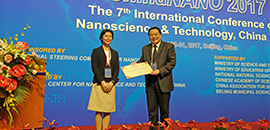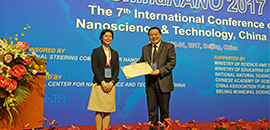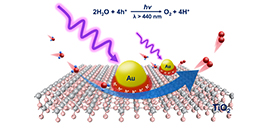Research News
-
 09 27, 2017Professor BAO Gives a Plenary Lecture at ChinaNANO 2017 and Receives the ChinaNANO Award
09 27, 2017Professor BAO Gives a Plenary Lecture at ChinaNANO 2017 and Receives the ChinaNANO Award
The 7th International Conference on Nanoscience and Technology, China 2017 (ChinaNANO 2017) was held in Beijing on August 29 to 31.
Seven distinguished researchers, including the Nobel Prize laureate and co-inventor of graphene, Professor Konstantin Novoselov, were invited to deliver the plenary lecture at the conference. Professor BAO gave a plenary lecture on "Nano Confinement and Catalytic Conversion of Energy Molecules" and was awarded the ChinaNANO Award.
ChinaNANO has developed into a comprehensive international brand conference with strong international influence. Since the first ChinaNANO in 2005, the conference has been held once every two years. ChinaNANO 2017 has attracted more than 2,300 delegates from over 30 countries and regions.
In addition to the high level academic exchanges, the conference also presents a general assembly of the latest nanoscience and technology from China and abroad. "Clean and Highly Efficient Catalytic Conversion of Small Energy Molecules to High Value Chemicals" from our institute is a representative achievement of the Strategic Pilot Special (A) project from Chinese Academy of Sciences and was presented during the conference. Our achievement received high praise from the delegates and Prof. BAI, who is the President of the Chinese Academy of Sciences. (Text and Image by JIANG Xiumei) -
 09 27, 2017Professor BAO Gives a Plenary Lecture at ChinaNANO 2017 and Receives the ChinaNANO Award
09 27, 2017Professor BAO Gives a Plenary Lecture at ChinaNANO 2017 and Receives the ChinaNANO Award
The 7th International Conference on Nanoscience and Technology, China 2017 (ChinaNANO 2017) was held in Beijing on August 29 to 31.
Seven distinguished researchers, including the Nobel Prize laureate and co-inventor of graphene, Professor Konstantin Novoselov, were invited to deliver the plenary lecture at the conference. Professor BAO gave a plenary lecture on "Nano Confinement and Catalytic Conversion of Energy Molecules" and was awarded the ChinaNANO Award.
ChinaNANO has developed into a comprehensive international brand conference with strong international influence. Since the first ChinaNANO in 2005, the conference has been held once every two years. ChinaNANO 2017 has attracted more than 2,300 delegates from over 30 countries and regions.
In addition to the high level academic exchanges, the conference also presents a general assembly of the latest nanoscience and technology from China and abroad. "Clean and Highly Efficient Catalytic Conversion of Small Energy Molecules to High Value Chemicals" from our institute is a representative achievement of the Strategic Pilot Special (A) project from Chinese Academy of Sciences and was presented during the conference. Our achievement received high praise from the delegates and Prof. BAI, who is the President of the Chinese Academy of Sciences. (Text and Image by JIANG Xiumei) -
 09 27, 2017DICP Researchers Develop a Plasmon-Induced Overall Water Splitting System
09 27, 2017DICP Researchers Develop a Plasmon-Induced Overall Water Splitting System
Plasmonic nanostructures which are characterized by strong light absorption through the excitations of collective free electron oscillations is known as surface plasmon resonance (SPR). Such nanostructures have recently shown a great potential for solar energy conversion.
Although the plasmonic hot electrons in water reduction have been extensively studied, exactly how the plasmonic hot holes participate in the water splitting reaction has not yet been well understood. In particular, it's still illusive that where the plasmonic hot holes participate in water oxidation.
Recently, the research group led by Prof. LI Can in Dalian Institute of Chemical Physics (DICP) of the Chinese Academy of Sciences (CAS), identified the water oxidation reaction sites in plasmonic photocatalyst Au/TiO2 and fabricated a visible-light-induced overall water splitting system based on surface plasmon effect. This work has been published in J. Am. Chem. Soc. (DOI: 10.1021/jacs.7b04470).
They clearly demonstrated that the plasmon-induced water oxidation reaction takes place at the reaction sites localized at the interface between Au and TiO2. The reaction sites are positioned by photodeposition together with element mapping by electron microscopy, while the distribution of holes is probed by surface photovoltage imaging with Kelvin probe force microscopy. Density functional theory also corroborates these findings by revealing the promotion role of interfacial structure (Ti-O-Au) for oxygen evolution.
Gold-semiconductor interface is identified as reaction sites for water oxidation
On the basis of this found, they successfully assembled an artificial Z-scheme photosynthesis system with redox ions for overall water splitting under visible light illumination. What’s more, this group even developed an all-solid plasmon-induced Z-scheme system for overall water splitting, very recently. This is more important and challenge to achieve overall water splitting in an all-solid artificial photosynthesis system. This work has been published in J. Catal..
The above work was supported financially by National Natural Science Foundation of China, 973National Project (Grant No. 2014CB239400), the Strategic Priority Research Program of the Chinese Academy of Sciences, and the DICP Innovation Foundation. (Text and Imaged by WANG Shengyang) -
 09 27, 2017DICP Researchers Develop a Plasmon-Induced Overall Water Splitting System
09 27, 2017DICP Researchers Develop a Plasmon-Induced Overall Water Splitting System
Plasmonic nanostructures which are characterized by strong light absorption through the excitations of collective free electron oscillations is known as surface plasmon resonance (SPR). Such nanostructures have recently shown a great potential for solar energy conversion.
Although the plasmonic hot electrons in water reduction have been extensively studied, exactly how the plasmonic hot holes participate in the water splitting reaction has not yet been well understood. In particular, it's still illusive that where the plasmonic hot holes participate in water oxidation.
Recently, the research group led by Prof. LI Can in Dalian Institute of Chemical Physics (DICP) of the Chinese Academy of Sciences (CAS), identified the water oxidation reaction sites in plasmonic photocatalyst Au/TiO2 and fabricated a visible-light-induced overall water splitting system based on surface plasmon effect. This work has been published in J. Am. Chem. Soc. (DOI: 10.1021/jacs.7b04470).
They clearly demonstrated that the plasmon-induced water oxidation reaction takes place at the reaction sites localized at the interface between Au and TiO2. The reaction sites are positioned by photodeposition together with element mapping by electron microscopy, while the distribution of holes is probed by surface photovoltage imaging with Kelvin probe force microscopy. Density functional theory also corroborates these findings by revealing the promotion role of interfacial structure (Ti-O-Au) for oxygen evolution.
Gold-semiconductor interface is identified as reaction sites for water oxidation
On the basis of this found, they successfully assembled an artificial Z-scheme photosynthesis system with redox ions for overall water splitting under visible light illumination. What’s more, this group even developed an all-solid plasmon-induced Z-scheme system for overall water splitting, very recently. This is more important and challenge to achieve overall water splitting in an all-solid artificial photosynthesis system. This work has been published in J. Catal..
The above work was supported financially by National Natural Science Foundation of China, 973National Project (Grant No. 2014CB239400), the Strategic Priority Research Program of the Chinese Academy of Sciences, and the DICP Innovation Foundation. (Text and Imaged by WANG Shengyang) -
 09 26, 2017The Denitrification Technology of Coke Oven Flue Gas Developed by DICP has been Widely Used in the Coking Industry
09 26, 2017The Denitrification Technology of Coke Oven Flue Gas Developed by DICP has been Widely Used in the Coking Industry
From May 2017, four DeNOx industrial units have been successfully carried out in Hebei Donghai Steel group Co. Ltd (flue-gas flux: 250000Nm3/hr), Xuzhou Dongxing Energy Co. Ltd (flue-gas flux: 300000Nm3/hr), Tangshan Dafeng Coking Co. Ltd (flue-gas flux: 170000Nm3/hr), Qian’an Jiujiang Coal Storage and Transportation Company (flue-gas flux: 250000Nm3/hr) for removal of NOx from coke oven flue gas. These units were all loaded with high-efficiency low-temperature DeNOx catalysts developed by DNL0901.
Since 2013, DNL0901 has focused on the denitrification of coke oven flue gas, and developed an efficient low-temperature SCR catalyst for the denitrification of coke oven flue gas.
In 2015, DNL0901 jointed with Jiangsu WOTE environmental protection equipment Engineering Co. Ltd and Jiangsu Yizhou Coking Co. Ltd to establish the first low-temperature DeNOx industrial demonstration unit for reduction of NOx emissions from the 3# coke oven in Jiangsu Yizhou Coking Co. Ltd, and in 2016 Jiangsu Yizhou Coking Co. Ltd continued to use our technology for the denitration construction of the remaining three coke oven.
These four sets of denitration device have run stably in more than one year and the stable operation of these four sets has played a good demonstration role in the process of flue gas denitration in the coking industry of China.
This year, our denitration technology continues to be widely used in the coking industry. Since the commissioning of these four units, the outlet nitrogen oxide concentration of the denitrification unit can be less than 100 mg/m3, which shows very good denitrification effect, and ensures that the nitrogen oxides of the coke oven flue gas meet the standard limit. (Text by HAO Cheng, Image by LI Defu) -
 09 26, 2017The Denitrification Technology of Coke Oven Flue Gas Developed by DICP has been Widely Used in the Coking Industry
09 26, 2017The Denitrification Technology of Coke Oven Flue Gas Developed by DICP has been Widely Used in the Coking Industry
From May 2017, four DeNOx industrial units have been successfully carried out in Hebei Donghai Steel group Co. Ltd (flue-gas flux: 250000Nm3/hr), Xuzhou Dongxing Energy Co. Ltd (flue-gas flux: 300000Nm3/hr), Tangshan Dafeng Coking Co. Ltd (flue-gas flux: 170000Nm3/hr), Qian’an Jiujiang Coal Storage and Transportation Company (flue-gas flux: 250000Nm3/hr) for removal of NOx from coke oven flue gas. These units were all loaded with high-efficiency low-temperature DeNOx catalysts developed by DNL0901.
Since 2013, DNL0901 has focused on the denitrification of coke oven flue gas, and developed an efficient low-temperature SCR catalyst for the denitrification of coke oven flue gas.
In 2015, DNL0901 jointed with Jiangsu WOTE environmental protection equipment Engineering Co. Ltd and Jiangsu Yizhou Coking Co. Ltd to establish the first low-temperature DeNOx industrial demonstration unit for reduction of NOx emissions from the 3# coke oven in Jiangsu Yizhou Coking Co. Ltd, and in 2016 Jiangsu Yizhou Coking Co. Ltd continued to use our technology for the denitration construction of the remaining three coke oven.
These four sets of denitration device have run stably in more than one year and the stable operation of these four sets has played a good demonstration role in the process of flue gas denitration in the coking industry of China.
This year, our denitration technology continues to be widely used in the coking industry. Since the commissioning of these four units, the outlet nitrogen oxide concentration of the denitrification unit can be less than 100 mg/m3, which shows very good denitrification effect, and ensures that the nitrogen oxides of the coke oven flue gas meet the standard limit. (Text by HAO Cheng, Image by LI Defu)